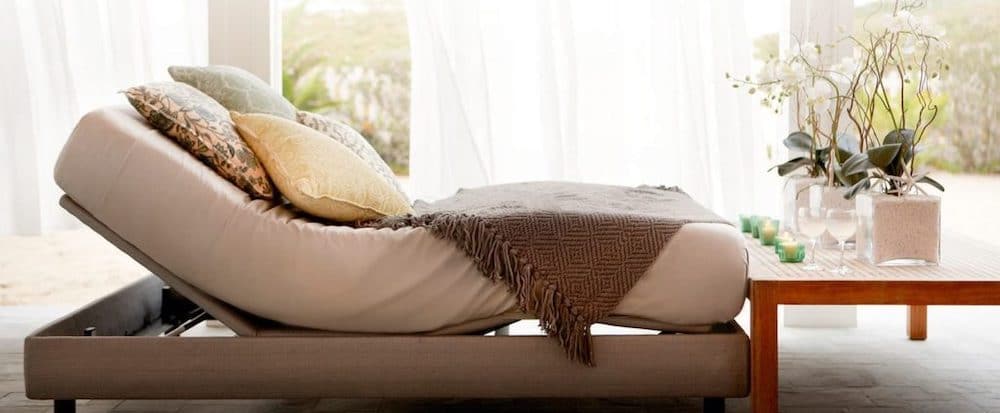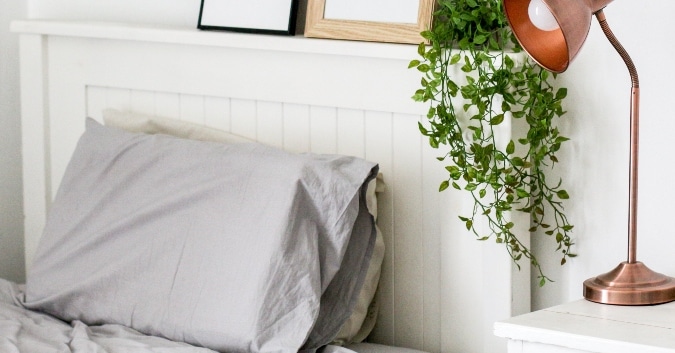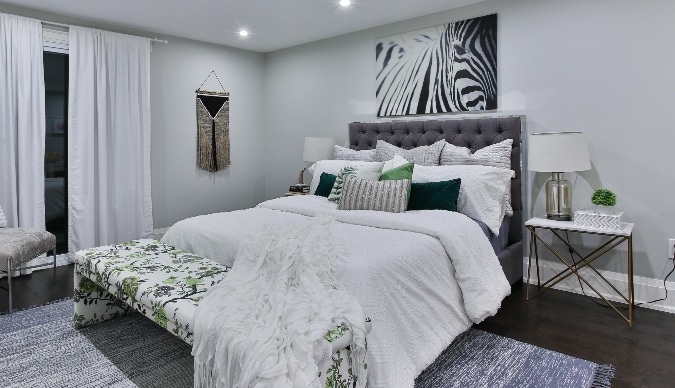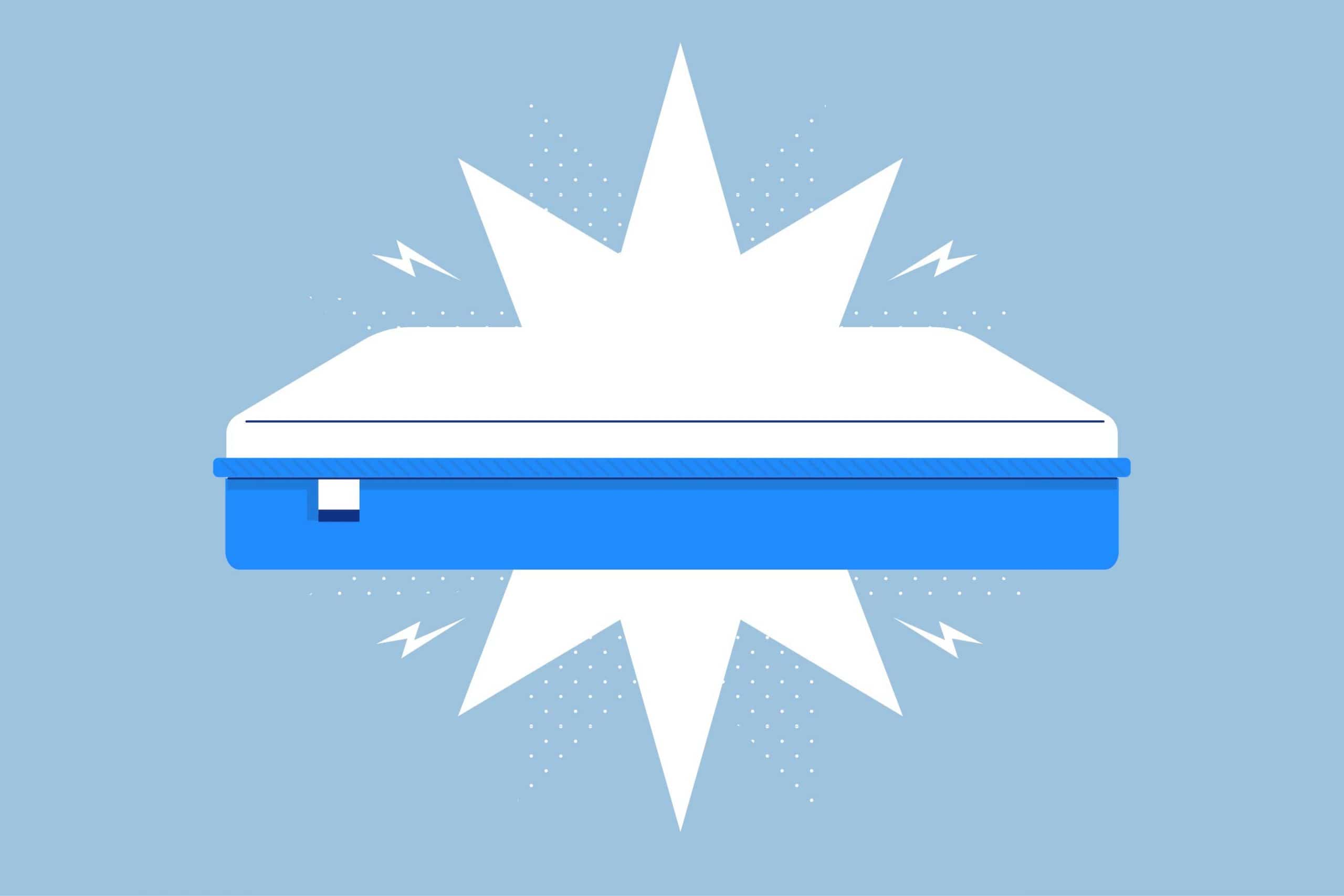While not as common as side sleeping, about 10 percent of Americans sleep on their backs, compared to 74 percent who sleep on their sides. Back sleeping enables the spine to rest in neutral spinal alignment. Back sleepers may need reinforced support for the lower back with pressure relief in the hips and shoulders for the best comfort. That’s why we recommend the AS2 mattress.
Consider the AS2
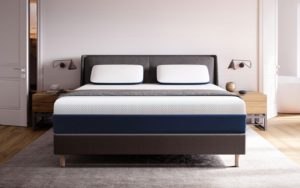
The AS2 is our medium-firm model, perfect for back and stomach sleepers. A 2-inch layer of Bio-Pur® provides a firmer surface to keep the body resting on top of the bed. 3 inches of the Affinity with HIVE® technology enhances support to the lower back, while 7 inches of Bio-Core® supports the body without risk of sinking.
Why Choose Amerisleep?
Each of our five mattress models (AS1, AS2, AS3, AS4, and AS5) is designed to provide a healthy balance of comfort and support for varying sleep needs. Our eco-friendly foams conform to the body, relieving pressure points without leaving sleepers feeling “stuck,” while the soft, breathable cover keeps you cool throughout the night.
Bio-Pur®
Bio-Pur® is plant-based memory foam. During the manufacturing process, we partially replace petroleum with castor oil to produce an eco-friendly foam that’s 5 times more breathable and 10 times more responsive than traditional memory foam. Bio-Pur® conforms to the body’s natural curves and cradles the lower back.
Affinity with HIVE®
The Affinity layer incorporates HIVE® technology. HIVE® contains hundreds of hexagonal-shaped segments that form a 5-zone support system; softer support rests under the shoulders and hips, and firmer support rests under the head, back, and legs. HIVE® evenly relieves pressure points in the body.
Bio-Core®
Bio-Core® provides a firm and supportive base that reinforces the top comfort layers and evenly distributes body weight on the sleep surface. Bio-Core® adds stability to the mattress and ensures it lasts.
100-Night Sleep Trial
We include a 100-night sleep trial with the purchase of any of our mattress models. During this trial period, customers can try out an Amerisleep mattress within the comfort of their own home. If the customer doesn’t like the mattress or would like to exchange for a different model or size, they can do so within the first 100 nights.
20-Year Warranty
We include a 20-year warranty with each mattress purchase— one of the best in the industry. Our warranty covers manufacturing defects and flaws which could damage the mattress, and sagging greater than 0.75 inches. During the first 10 years, we will repair or replace the mattress free of charge to the customer. During the last 10 years, we will either repair or replace the mattress at a prorated charge.
What is a Back Sleeper?
A person who sleeps flat on their back is a back sleeper. Back sleeping naturally aligns the spine because the spine is so close to the sleep surface. Back sleepers face some risks, including potential snoring, development of sleep apnea, and aggravating acid reflux.
Back sleepers need a medium to firm mattress for pressure point relief in the shoulders and hips, plus enhanced lumbar support.
Pros and Cons of Back Sleeping
Like any sleep position, there are both pros and cons to back sleeping. If you suffer from back pain, back sleeping may provide some relief, but if you have sleep apnea or are prone to snoring, we recommend switching to the side position.
Pros
- Natural spinal alignment
Cons
- Snoring potential
- Risk of developing sleep apnea
- Worsened acid reflux
The Right Mattress
Before committing to a mattress, consider firmness options, mattress type, and any available sleep trials, return policies, and warranties. Establishing these factors before shopping will narrow down your options and get you closer to finding the best mattress for your needs.
Firmness Scale
While many individuals give the advice that “firmer is better,” that’s not always the case. Choose a mattress firmness based on your sleep position and body type. Body type influences firmness by determining what level of comfort and support you need for a good night’s rest. Body types are divided up into three categories— light, average, and plus-size.
Light Sleepers
Light sleepers weigh 130 pounds or less. A softer mattress is better for them, since it enables the bed to conform to their bodies. A firmer surface may cause unnatural curves in the spine, throwing it out of alignment.
Average Sleepers
Average sleepers weigh between 130 and 230 pounds. A medium feel is the perfect firmness for most average sleepers— it offers a nice balance of cushion and support to the body for proper spinal alignment.
Heavy Sleepers
Plus-size sleepers weigh 230 pounds or more. Plus-size individuals need a firmer mattress, because it prevents their bodies from bottoming out and provides equal levels of pressure relief and support.
Mattress Type
Memory foam, innerspring, latex, and hybrid are the most common mattress types available on the market. Each mattress type offers their own unique feel for sleepers, but the mattress you choose may come down to what you prefer. For example, some sleepers want a mattress with more bounce like an innerspring, while others prefer the contouring feel of memory foam.
Memory Foam
Memory foam first appeared in mattresses back in the 90s and has since grown in popularity—beds in a box have only made them easier to get, since memory foam compresses easily to fit into a box. A memory foam mattress conforms to the body, relieving pressure points and reducing aches and pains. Memory foam also has excellent motion isolation and is quiet.
Generally, a memory foam mattress is an all-foam bed containing a comfort layer of memory foam and a support layer of high-density foam. Memory foam beds may also include a transitional layer of poly-foam.
Memory foam has the risk of overheating because of its dense structure. Choosing a memory foam mattress with cooling properties, like breathable, plant-based memory foam or heat-absorbing gel memory foam, reduces the risk of overheating and ensures a cooler sleep.
Innerspring
Innerspring mattresses are more popular than any other mattress type. An innerspring mattress has a bouncy surface with great edge support, so there’s less risk of sleepers rolling off the bed. Innersprings also provide better cooling through the open structure of their base layer.
An innerspring mattress contains pillow tops made of foam or fiberfill and a support layer of innerspring coils. Some innerspring mattresses may include a layer of microcoils for enhanced support.
Because of their thin comfort layers, innerspring mattresses have little to no pressure-relieving properties. Innerspring beds also have more noise potential and less motion isolation due to the coils. Adding a mattress topper may improve pressure point relief.
Latex
Latex foam is similar to memory foam— latex conforms to the body, though not as closely as memory foam and has excellent motion isolation. While memory foam retains heat, latex sleeps cooler and is responsive, making movement easier. A latex mattress contains a comfort layer of latex foam and a support layer of either high-density foam or latex.
Depending on how much natural latex the mattress contains, latex mattresses can come at a higher price point. They can also be heavier and harder to maneuver than other mattress types.
Hybrid
A hybrid mattress combines pressure-relieving memory foam and bouncy innerspring coils. With the benefits of both a memory foam mattress and an innerspring, hybrids are the perfect bed. However, hybrid mattresses also come with drawbacks of both mattress types: risk of overheating from memory foam and less pressure relief and motion transfer from innerspring coils. A hybrid mattress contains a comfort layer of either memory foam or latex (must be at least 2 inches thick) and a support layer of pocketed coils.
Because hybrids contain a combination of memory foam and innerspring coils, they’re heavier and more expensive than other mattress types.
Other Sleeping Positions
Other sleeping positions include side, stomach, and combination sleeping. Each sleep position requires a certain level of comfort and support to maintain spinal alignment. If you’re looking to switch to a healthier sleep position, especially if you have sleep apnea, we highly recommend side sleeping— it enables better breathing and may reduce sleep apnea symptoms.
Side Sleeping
Side sleeping is one of the most common sleep positions. Side sleepers breathe easier, put less pressure on their vital organs, and may experience reduced acid reflux symptoms. To prevent their spines from misaligning, side sleepers can place a pillow between the knees. The best mattresses for side sleepers are medium in firmness— a medium to plush surface fills in the large gap between the body and the surface, while extra cushioning relieves pressure points in the shoulders and hips.
Stomach Sleeping
Stomach sleeping is the least common position. Stomach sleepers have a greater risk of neck pain (twisting the head to breathe) and lower back pain (gravity pulls weight down, forcing the spine to straighten). Placing a thin pillow under the hips reduces pressure and may help relieve lower back pain. Stomach sleepers need a medium-firm to firm sleep surface, or the best mattress for back pain, to keep the body resting on top instead of sinking.
Combination Sleeping
Combination sleepers, or restless sleepers, regularly switch between 2 to 3 sleep positions a night. Combination sleepers have benefits of each sleep position, like less pressure on their organs and natural spinal alignment. However, combination sleepers also face drawbacks of each sleep position— risk of developing sleep apnea and neck strain. Combination sleepers need a medium to medium-firm mattress with a balance of comfort and support, keeping the spine in neutral alignment.
Sleep Trials, Return Policies, and Warranties
Take a look at any sleep trials, return policies, and warranties before committing to a new mattress. These perks reassure customers of a quality purchase.
Sleep Trial
A sleep trial allows customers to try a new mattress at home for an extended period of time. Sleep trials usually last between 90 to 120 nights. If the customer doesn’t like the mattress, most companies will donate it to a local charity.
Return Policy
A return policy is an okay substitute if a sleep trial isn’t available. Return policies last 30 days, about the same time it takes most individuals to adjust to a new bed. If not happy with the bed, customers can return the mattress for a full refund. Double check the fine print though— some mattress companies will only accept an unopened box.
Warranty
A warranty is designed to protect the mattress from any manufacturing defects and flaws which could damage the mattress and sagging greater than 1 inch— it doesn’t cover damage caused through customer misuse. Most mattresses come with a standard 10-year warranty, but only for the original purchaser.
FAQs
What is the best type of mattress for back sleepers?
Memory foam or latex are the best mattress types for back sleepers— their conforming properties relieve pressure points and isolate motion.
Are hard or soft beds better for your back?
Soft mattresses may not be the best choice— deep sinking can misalign the spine. A firmer mattress is the best option for back sleepers by keeping the body resting on top of the bed and relieving pressure points in the shoulders and hips.
The Right Mattress for Back Sleepers
The best mattress for back sleepers is the AS2 mattress— its medium-firm surface relieves pressure points and provides enhanced support to the lower back. Back sleepers will feel nicely supported without finding the mattress too hard or too soft.
About the author
McKenzie Hyde is a Certified Sleep Science Coach and a full-time writer focused on sleep health and the mattress industry. She currently writes articles on a variety of topics, ranging from sleep hygiene to the newest trends in the mattress and bedding industry. Just some of the topics she has covered include best sleep practices for students, the consequences of going without sleep, and choosing the right bed if you suffer from back pain. McKenzie Hyde holds a Master of Arts degree from Utah State University where she studied literature and writing. While there, she taught argumentative writing and wrote a variety of articles and analyses for literary and academic journals.
View all posts